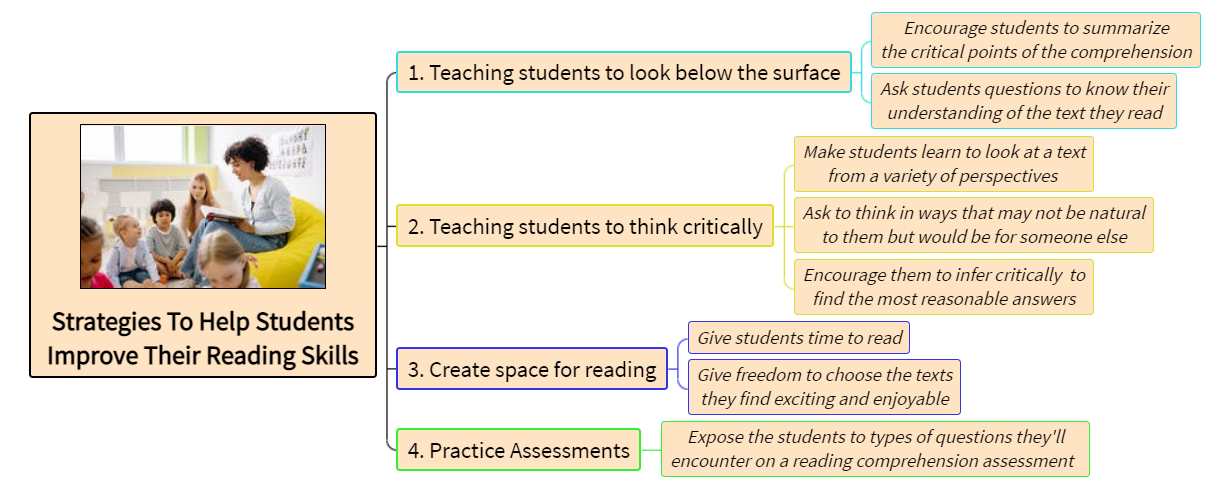Strategies for teachers to help students do better on the reading comprehension
 State reading comprehension assessments are often a significant challenge for teachers and the students they’re trying to prepare to take them. Not all students read on the same level, and today’s students often struggle here more than in any other subject.
State reading comprehension assessments are often a significant challenge for teachers and the students they’re trying to prepare to take them. Not all students read on the same level, and today’s students often struggle here more than in any other subject.
There are some strategies to help students improve their reading skills and perform better on these tests.
Teaching Students to Look Below the Surface
One key to performing well on reading comprehension assessments is being able to look below the surface of a text and infer what the author isn’t saying explicitly. The problem for many students, however, begins with reading just the surface of the text.
Students will often declare that they don’t understand something after they read it, but it’s critical for us as teachers to get below what our students mean when they say this. I’ve found that for many of the students I’ve taught, the phrase “I don’t understand” for them means, “I don’t know what I just read.”
More clearly, they often believe they lack the most foundational of reading skills, which is the ability to read something and summarize what the author said. Students can’t get below the surface of a text if they don’t think they can even understand what’s happening in a text.
When a student tells me she doesn’t understand something she’s read, I’ll often respond with something like, “Can you tell me what the author said?” If it’s a narrative, I’ll ask the student to summarize what happened in the text. Most of the time, students will respond with an accurate summary of what the author wrote, and then I’m able to affirm for them that they did understand the text, so now they can go deeper.
The ability to summarize the most critical points of a text is a vital first step toward answering the types of reading comprehension questions asked on state assessments. Teachers can encourage their students, as they’re reading, to make summaries of what they’ve learned in the margins of the text.
Teaching Students to Think Critically
Many comprehension questions require the student to make an inference about the text. The thing about inferring, however, is that it’s often a subjective experience that varies from reader to reader. For example, The Giving Tree is a famous story by author Shel Silverstein about an apple tree that spends its life loving a boy who plays with the tree as a young boy. The story follows the young boy as he grows up, and during each stage of the boy’s life, the tree gives parts of itself to the boy to continue to make him happy. This includes apples for selling and wood to make a house and a boat. The story ends with the boy, grown to be an old man, visiting the tree, who is now only a stump after giving everything for the boy’s happiness. The old man sits on the tree, and the tree is happy.
Some readers may come away from this story making the inference that the author meant to tell a story about generosity and why it’s essential to give to those you love. Another reader, however, may read the story and become convinced that the author is trying to tell a cautionary tale about being in an abusive relationship in which one partner is constantly taking from the other.
Which reader’s inference is correct?
Both of them. Every reader thinks differently and comes to the text with different experiences and assumptions that impact how they understand a text.
It’s important to understand that when test makers create reading comprehension tests, they form questions and answer choices that are reasonable and logical conclusions a reader might make. It might not be the inference you would make, but it’s a reasonable inference another reader might make. This is why I teach my students that when they’re looking at a multiple-choice question in which they’re required to make an inference to think critically about the answers and try to find the most reasonable answer, even if it’s not the answer they would automatically go to.
Students need to learn to look at a text from a variety of perspectives and to think in ways that may not be natural to them but would be for someone else.
Proven Assessment Rehearsal Programs
Used by Over 20,000 Schools
Creating Space for Reading
Learning to read well is like any other skill. It requires time to practice to improve. Teachers can encourage their students to become better readers by giving them time to read and the freedom to choose texts they find exciting and enjoyable.
I often give my students several minutes at the beginning of a class to read independently from a book of their choice. Teachers can build classroom libraries full of books that appeal to their students, or they can schedule a time to take their students to the library to choose books.
Expecting students to perform well on a state reading assessment should drive teachers to give students the time and space to read frequently.
Practice Assessments
Students should be exposed to the types of questions they’ll encounter on a state reading comprehension assessment, so they have an idea of the expectations of the questions. Lumos Learning has hundreds of free reading passages from different genres that are mapped to appropriate reading levels, grades, and learning standards, which can be printed and used in classrooms to help students practice on reading comprehension.






